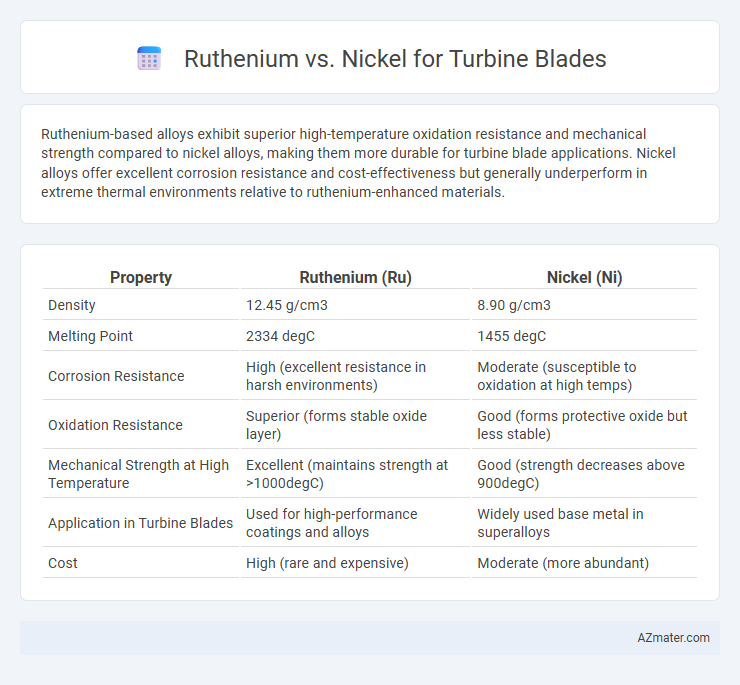Ruthenium-based alloys exhibit superior high-temperature oxidation resistance and mechanical strength compared to nickel alloys, making them more durable for turbine blade applications. Nickel alloys offer excellent corrosion resistance and cost-effectiveness but generally underperform in extreme thermal environments relative to ruthenium-enhanced materials.
Table of Comparison
| Property | Ruthenium (Ru) | Nickel (Ni) |
|---|---|---|
| Density | 12.45 g/cm3 | 8.90 g/cm3 |
| Melting Point | 2334 degC | 1455 degC |
| Corrosion Resistance | High (excellent resistance in harsh environments) | Moderate (susceptible to oxidation at high temps) |
| Oxidation Resistance | Superior (forms stable oxide layer) | Good (forms protective oxide but less stable) |
| Mechanical Strength at High Temperature | Excellent (maintains strength at >1000degC) | Good (strength decreases above 900degC) |
| Application in Turbine Blades | Used for high-performance coatings and alloys | Widely used base metal in superalloys |
| Cost | High (rare and expensive) | Moderate (more abundant) |
Introduction: The Importance of Alloying Elements in Turbine Blades
Ruthenium and nickel play critical roles as alloying elements in turbine blade materials, influencing their mechanical strength and corrosion resistance at high temperatures. Ruthenium enhances creep resistance and oxidation stability in superalloys, making it valuable for advanced turbine blades operating in extreme environments. Nickel, the primary constituent in most turbine blade superalloys, provides excellent high-temperature strength and corrosion resistance essential for maintaining blade integrity and performance.
Chemical Properties: Ruthenium Versus Nickel
Ruthenium exhibits superior corrosion resistance and higher melting point compared to nickel, enhancing turbine blade durability under extreme thermal and oxidative conditions. Nickel offers excellent ductility and toughness but is more prone to oxidation and creep deformation at elevated temperatures. The chemical inertness of ruthenium contributes to improved high-temperature performance, making it advantageous for turbine blade applications requiring enhanced thermal stability and structural integrity.
Mechanical Strength: Performance Under Stress
Ruthenium exhibits superior mechanical strength compared to nickel when used in turbine blades, maintaining high resistance to stress and deformation at elevated temperatures. Its enhanced creep resistance and tensile strength contribute to prolonged blade life and reliability in extreme operational environments. Nickel alloys, while strong, typically underperform ruthenium alloys under cyclic stress and thermal fatigue conditions common in turbine applications.
High-Temperature Stability and Oxidation Resistance
Ruthenium enhances turbine blade performance by significantly improving high-temperature stability and oxidation resistance compared to nickel, thanks to its ability to form stable oxide layers that protect the blade surface at extreme temperatures. Nickel-based superalloys are widely used in turbine blades for their good mechanical strength and corrosion resistance but tend to suffer from oxidation and phase instability at temperatures exceeding 1100degC. Incorporating ruthenium into nickel superalloys increases creep strength and mitigates grain boundary degradation, extending turbine blade lifespan in high-temperature, oxidative environments.
Corrosion Resistance in Turbine Environments
Ruthenium exhibits superior corrosion resistance in high-temperature turbine environments compared to nickel, largely due to its excellent oxidation resistance and ability to form stable protective oxide layers. Nickel alloys, while commonly used in turbine blades for their strength and thermal stability, tend to suffer from accelerated oxidation and hot corrosion under aggressive conditions involving sulfur and salt deposits. The addition of ruthenium enhances the alloy's durability by improving resistance to high-temperature sulfidation and oxidation, making it a preferred choice for advanced turbine blade coatings and high-performance superalloys.
Cost and Availability: Ruthenium vs Nickel
Ruthenium is significantly more expensive than nickel due to its rarity and complex extraction process, impacting its cost-effectiveness for turbine blade manufacturing. Nickel, widely available and abundant in global markets, offers a more economical choice without compromising essential mechanical properties. Availability of nickel ensures consistent supply chains, whereas ruthenium's limited production volumes can lead to price volatility and sourcing challenges.
Impact on Turbine Blade Longevity
Ruthenium significantly enhances turbine blade longevity by improving high-temperature oxidation resistance and preventing grain boundary degradation, outperforming nickel in extreme thermal environments. Nickel-based alloys, while offering good strength and corrosion resistance, tend to degrade faster under prolonged high-temperature exposure, leading to reduced blade lifespan. Incorporating ruthenium into turbine blade superalloys promotes structural stability and extends operational durability, crucial for maintaining performance in advanced gas turbines.
Suitability for Next-Generation Turbine Technology
Ruthenium's exceptional high-temperature oxidation resistance and strong solid-solution strengthening make it highly suitable for next-generation turbine blades, outperforming nickel in environments exceeding 1,200degC. Nickel-based superalloys, while widely used, often require doping with elements like ruthenium to enhance creep resistance and thermal stability. The integration of ruthenium into turbine blade alloys enables longer service life and improved efficiency in ultra-high temperature turbine applications.
Environmental Considerations and Sustainability
Ruthenium-enhanced turbine blades demonstrate superior corrosion resistance and longer service life compared to nickel-based alloys, reducing the frequency of replacements and waste generation. Ruthenium's ability to withstand extreme operating conditions improves overall turbine efficiency, leading to lower fuel consumption and reduced greenhouse gas emissions. However, the scarcity and cost of ruthenium necessitate sustainable mining practices and recycling to mitigate environmental impacts and ensure resource availability.
Conclusion: Choosing Between Ruthenium and Nickel for Turbine Blades
Ruthenium offers superior corrosion resistance and higher melting points compared to nickel, making it ideal for high-temperature turbine blade applications. Nickel provides excellent strength and durability at a lower cost but may require additional coatings to enhance oxidation resistance. Selecting between ruthenium and nickel depends on balancing budget constraints with performance requirements in extreme operating environments.

Infographic: Ruthenium vs Nickel for Turbine Blade
 azmater.com
azmater.com